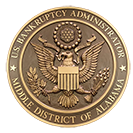STATEMENT OF INFORMATION REQUIRED BY 11 U.S.C. § 341
INTRODUCTION
Pursuant to Section 341 of the Bankruptcy Code, the Office of the United States Bankruptcy Administrator has prepared this information sheet to help you understand some of the possible consequences of filing a bankruptcy petition under chapter 7 of the Bankruptcy Code. This information is intended to make you aware of -
(1) the potential consequences of seeking a discharge in bankruptcy, including the effects on credit history;
(2) the effect of receiving a discharge of debts in bankruptcy;
(3) the effect of reaffirming a debt; and
(4) your ability to file a petition under a different chapter of the Bankruptcy Code.
There are many other provisions of the Bankruptcy Code that may affect your situation. This statement contains only general principles of law and is not a substitute for legal advice. If you have any questions or need further information as to how the bankruptcy laws apply to your specific case, you should consult with your lawyer.
WHAT IS A DISCHARGE?
The filing of a chapter 7 petition is designed to result in a discharge of most of the debts you listed in your bankruptcy schedules. A discharge is a court order that says that you do not have to repay your debts, but there are several exceptions. Debts which usually may not be discharged in your chapter 7 case include, for example, most taxes, child support, alimony, and student loans; court-ordered fines and restitution; debts obtained through fraud or deception; debts which were not listed in your bankruptcy schedules; and personal injury debts caused by driving while intoxicated or taking drugs. Your discharge may be denied entirely if you, for example, destroy or conceal property; destroy, conceal, or falsify records; or make a false oath. Creditors cannot ask you to repay debts which have been discharged. You can only receive a chapter 7 discharge once every eight (8) years.
WHAT ARE THE POTENTIAL EFFECTS OF A DISCHARGE?
The fact that you filed bankruptcy can appear on your credit report for as long as 10 years. Thus, filing a bankruptcy petition may affect your ability to obtain credit in the future. Also, you may not be excused from repaying debts that were not listed on your bankruptcy schedules or that you incurred after you filed bankruptcy. There are exceptions to this general statement. See your lawyer if you have any questions.
WHAT ARE THE EFFECTS OF REAFFIRMING A DEBT?
After you file your bankruptcy petition, a creditor may ask you to reaffirm a certain debt or you may seek to do so on your own. Reaffirming a debt means that you sign and file with the court a legally enforceable document which states that you promise to repay all or a portion of the debt that may otherwise have been discharged in your bankruptcy case. Reaffirmation agreements must generally be filed with the Court sixty (60) days after the first meeting of creditors.
Reaffirmation agreements are strictly voluntary. They are not required by the Bankruptcy Code or other state or federal law. You can voluntarily repay any debt instead of signing a reaffirmation agreement, but there may be valid reasons for wanting to reaffirm a particular debt. This is particularly true when property that you wish to retain is collateral for a debt.
Reaffirmation agreements must not impose an undue burden on you or your dependents and must be in your best interest. If you decide to sign a reaffirmation agreement, you may cancel it at any time before the court issues an order of discharge or within sixty (60) days after you filed the reaffirmation agreement with the court, whichever is later.
If you reaffirm a debt and fail to make the payments as required in the reaffirmation agreement, the creditor can take action against you to recover any property that was given as security for the loan and you may remain personally liable for any deficiency. In addition, creditors may seek other remedies, such as garnishment of wages.
OTHER BANKRUPTCY OPTIONS
You have a choice in deciding what chapter of the Bankruptcy Code will best suit your needs. Even if you have already filed for relief under chapter 7, you may be eligible to convert your case to a different chapter.
Chapter 7 is the liquidation chapter of the Bankruptcy Code. Under chapter 7, a trustee is appointed to collect and sell, if economically feasible, all property you own that is not exempt from these actions.
Chapter 13 generally permits individuals to keep their property by repaying creditors out of their future income. Each chapter 13 debtor writes a plan which must be approved by the Bankruptcy Court. The debtors must pay the chapter 13 trustee the amount set forth in their plan. Debtors receive a discharge after they complete their chapter 13 repayment plan. Chapter 13 is only available to individuals with regular income whose debts do not exceed $1,395,875 of secured debt, and $465,275 of unsecured debt.
Chapter 11 is the reorganization chapter mostly used by businesses but is also available to individuals. Creditors vote on whether to accept or reject a plan, which also must be approved by the Court. While the debtor normally remains in control of the assets, the Court can order the appointment of a trustee to take possession and control of the business.
Chapter 12 offers bankruptcy relief to those who qualify as family farmers. Family farmers must propose a plan to repay their creditors over a three-to-five-year period and it must be approved by the Court. Plan payments are made through a chapter 12 trustee, who also monitors the debtor’s farming operations during the pendency of the plan.
AGAIN, PLEASE SPEAK TO YOUR LAWYER IF YOU NEED FURTHER INFORMATION OR EXPLANATION, INCLUDING HOW THE BANKRUPTCY LAWS RELATE TO YOUR SPECIFIC CASE.
Effective June 24, 2024
